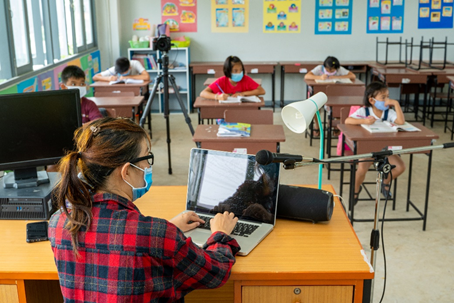
THE FUTURE OF EAP, POST COVID19 Part 3
This is Part 3 of a 3-part series based on a Zoom interview I did with Rick Vinnay, Executive Director of The Solutions Group, an Internal/External EAP and Wellness Program based in Albuquerque, New Mexico. You can see Part 3 of the interview at the link below.
Rick was reflecting on remote learning and the stress that teachers and parents face right now with Covid19 and this seems to all boil down to one thing: How do you create an environment for teachers and students where everyone feels safe. Rick explained that we dealt with this in our frontline workers who work in healthcare and now we are looking at trying to achieve a level of comfort and safety for other workers who can no longer work from home like teachers. If you can’t help employees feel safe, he said you are going to have a very stressed out population.
As of the date of our interview, teachers were still working remotely in New Mexico. As Rick explains: “For any worker who interacts with the public, safety should be the employer’s #1 concern. Whether it’s making masks and sanitizer available, setting up plexiglass screens, or managing to achieve social distancing in a school system by dramatically cutting down the number of students in attendance on any given day, if employers don’t address these issues, it will have an adverse effect on an employee’s productivity.”
For the time being, remote learning has provided this much needed level of safety for teachers and students, but for parents is has been a huge stressor. He believes that employers need to be MORE flexible with these employees who are parents of school-age children – even in comparison to other employees. He says the other employees are not going to mind if the employer is MORE flexible with the employee with school-age children. These other employees generally realize that parents need that added flexibility in their lives especially for those having to work AND do home schooling. Rick also points out that even a little consideration for these employees, like having patience, when a child interrupts a Zoom meeting, must be tolerated as part of where we are right now.
I asked Rick to give us an example of how The Solutions Group (or their employer groups) had helped employees with young children and he said, one of their groups figured out how to let their medical assistants work from home. “Before Covid, no one would have dreamed that that was possible, but after Covid they figured out a way to make this work. And it’s no coincidence that a lot of these medical assistants were parents of small children.”
When I asked Rick if there were employers (or particular bosses) out there who still believed in the old-fashioned notion that work comes first and family second, he pointed out that this lack of understanding is often the result of generational differences. “Despite the pandemic, many baby boomers still believe that you have to be at work to be working. Working from home, especially for parents of small children may mean working on a non-traditional schedule. A millennial might be up in the middle of the night working with clients, who may be halfway around the globe. If his or her boss takes the time to have a conversation about why they didn’t start working until 10 AM: They will find that the employee was up in the middle of the night writing, or researching a potential client online or as we said above, trying to speak with a client in Asia, for example.
This conversation naturally segued into a discussion of “over-productivity” where some employees now are spending way too much time working because they don’t have any natural boundaries between work life and home life that we had before Covid19 where we were kind of forced to stop working at the end of the day. This as Rick so accurately points out can easily lead to an employee who is totally burned out.
One of my own clients surprised me with a similar story that Rick confirmed is quite common today: She told me that working from home is saving her two hours of commuting time each day. Naturally, I assumed that would free her up for a little more time for self-care. No she said, Frankly I’m just working two hours more each day at least.
Setting an example of how to set those boundaries from the top down is one of the things Rick and I agreed must be done to prevent this issue from getting out of hand. Employees know when a boss is working in the middle of the night, when emails arrive at all hours. This is NOT setting an example that employees should necessarily follow. Also individualizing your approach to each employee like we talked about with employees with school-aged children. It’s all about increased flexibility. This can be a great weapon against stress and burnout. It’s a completely different landscape now, and we have to approach the way we deliver EAP in a whole new way.





James Porter
Author